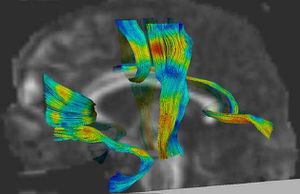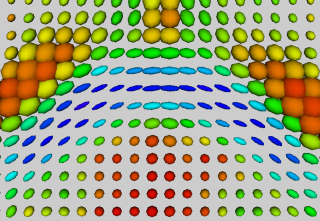Algorithm:UNC:DTI
Contents
Quantitative Tract Analysis
Tractography has commonly been used to visualize the geometry of fiber tract bundles. The aim of this project is to use tractography as a reference coordinate system for doing fiber tract statistics along a bundle.
Population Analysis
Our methodology for population analysis of DT-MRI is based on unbiased non-rigid registration of a population to a common coordinate system. The registration jointly produces an average DTI atlas, which is unbiased with respect to the choice of a template image, along with diffeomorphic correspondence between each image. The registration image match metric uses a feature detector for thin fiber structures of white matter, and interpolation and averaging of diffusion tensors use the Riemannian symmetric space framework. The anatomically significant correspondence provides a basis for comparison of tensor features and fiber tract geometry in clinical studies.
Our registration procedure is based on a scalar feature image which is sensitive to sheet like structures. We have observed that the major fiber bundles of interest occur as sheet or tube like manifolds in the FA image of the brain. As a feature image we use the maximum eigenvalue of the hessian of the FA image. Images are initially aligned using an affine registration and then deformed to a common coordinate system using the unbiased atlas-building procedure of Joshi et al. [1]. The deformation fields produced by the registration process are applied to the tensors fields using appropriate methods for reorienting and interpolating tensors. The transformed images are averaged in the atlas space to produce a DTI atlas.
An initial test was performed by using the procedure on a set of images of healthy subject at age one year. The results of the tensor averaging are shown on the right. Tractography was also performed on the mean atlas image as shown.
Noise Statistics
Clinical time limitations on the acquisition of diffusion weighted volumes in DTI present several key challenges for quantiative statistics of diffusion tensors and tensor-derived measures. First, the signal to noise ratio (SNR) in each individual diffusion weighted volume is relatively low due to the need for quick acquisition. Secondly, the presence of Rician noise in MR imaging can introduce bias in the estimation of anisotropy and trace. Unlike structural MRI where intensities are primarily used to obtain contrast, the goal of DTI is to quantify the local diffusion properties in each voxel. Therefore, an understanding of the influence of imaging noise on the distribution of measured values is important to understand the results of statistical analysis and to design new imaging protocols.
Publications
- Isabelle Corouge, P.Thomas Fletcher, Sarang Joshi, Sylvain Gouttard, Guido Gerig, Fiber Tract-Oriented Statistics for Quantitative Diffusion Tensor MRI Analysis. Medical Image Analysis 10 (2006), 786 - 798 PDF
- C. Goodlett, I. Corouge, M. Jomier, and G. Gerig, A Quantitative DTI Fiber Tract Analysis Suite, The Insight Journal, vol. ISC/NAMIC/ MICCAI Workshop on Open-Source Software, 2005, Online publication
- Corouge, I., Fletcher, T., Joshi, S., Gilmore J.H., and Gerig, G., Fiber Tract-Oriented Statistics for Quantitative Diffusion Tensor MRI Analysis, Lecture Notes in Computer Science LNCS, James S. Duncan and Guido Gerig, editors, Springer Verlag, Vol. 3749, Oct. 2005, pp. 131 -- 138 PDF
- Casey Goodlett, Brad Davis, Remi Jean, John Gilmore, Guido Gerig. Improved Correspondence for DTI Population Studies via Unbiased Atlas Building. Proc. MICCAI 2006, Springer LNCS v. 4191, pp. 260 - 267.PDF
- Casey Goodlett, P. Thomas Fletcher, Weili Lin, and Guido Gerig. Noise-induced bias in low-direction diffusion tensor MRI: Replication of Monte-Carlo simulation with in-vivo scans. Accepted ISMRM 2007.
Software
- Algorithms written in ITK. GUI of prototype software written in QT (FiberViewer software). Prototype software tested in clinical studies at UNC. Validation tests with repeated DTI of same subject (6 cases). FiberTracking download
- Additionally available: ITK compatible fibertracking prototype tool FiberTracking to be used to study overlap/dissimilarity with other tools already available to NA-MIC: Functionality: reads raw MRI-DT data (6 direction Basser scheme), fiber tracking based on user-selected source and regions (S. Mori scheme), display of fibertracts and volumetric data, output: sets of streamlines in ITK polyline format attributedwith DTI properties and display parameteres (radiusof tubes, local color, etc.). FiberViewer download



